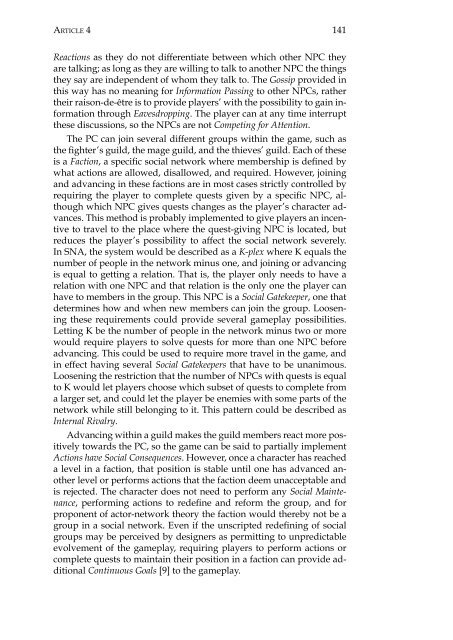Character Driven Game Design
Character Driven Game Design
Character Driven Game Design
Create successful ePaper yourself
Turn your PDF publications into a flip-book with our unique Google optimized e-Paper software.
Article 4 141<br />
Reactions as they do not differentiate between which other NPC they<br />
are talking; as long as they are willing to talk to another NPC the things<br />
they say are independent of whom they talk to. The Gossip provided in<br />
this way has no meaning for Information Passing to other NPCs, rather<br />
their raison-de-être is to provide players’ with the possibility to gain information<br />
through Eavesdropping. The player can at any time interrupt<br />
these discussions, so the NPCs are not Competing for Attention.<br />
The PC can join several different groups within the game, such as<br />
the fighter’s guild, the mage guild, and the thieves’ guild. Each of these<br />
is a Faction, a specific social network where membership is defined by<br />
what actions are allowed, disallowed, and required. However, joining<br />
and advancing in these factions are in most cases strictly controlled by<br />
requiring the player to complete quests given by a specific NPC, although<br />
which NPC gives quests changes as the player’s character advances.<br />
This method is probably implemented to give players an incentive<br />
to travel to the place where the quest-giving NPC is located, but<br />
reduces the player’s possibility to affect the social network severely.<br />
In SNA, the system would be described as a K-plex where K equals the<br />
number of people in the network minus one, and joining or advancing<br />
is equal to getting a relation. That is, the player only needs to have a<br />
relation with one NPC and that relation is the only one the player can<br />
have to members in the group. This NPC is a Social Gatekeeper, one that<br />
determines how and when new members can join the group. Loosening<br />
these requirements could provide several gameplay possibilities.<br />
Letting K be the number of people in the network minus two or more<br />
would require players to solve quests for more than one NPC before<br />
advancing. This could be used to require more travel in the game, and<br />
in effect having several Social Gatekeepers that have to be unanimous.<br />
Loosening the restriction that the number of NPCs with quests is equal<br />
to K would let players choose which subset of quests to complete from<br />
a larger set, and could let the player be enemies with some parts of the<br />
network while still belonging to it. This pattern could be described as<br />
Internal Rivalry.<br />
Advancing within a guild makes the guild members react more positively<br />
towards the PC, so the game can be said to partially implement<br />
Actions have Social Consequences. However, once a character has reached<br />
a level in a faction, that position is stable until one has advanced another<br />
level or performs actions that the faction deem unacceptable and<br />
is rejected. The character does not need to perform any Social Maintenance,<br />
performing actions to redefine and reform the group, and for<br />
proponent of actor-network theory the faction would thereby not be a<br />
group in a social network. Even if the unscripted redefining of social<br />
groups may be perceived by designers as permitting to unpredictable<br />
evolvement of the gameplay, requiring players to perform actions or<br />
complete quests to maintain their position in a faction can provide additional<br />
Continuous Goals [9] to the gameplay.
















